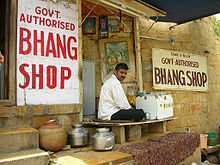Bhang
Bhang (Hindi: भाँग) is a preparation from the leaves and flowers (buds) of the female cannabis plant, consumed as a beverage in the Indian subcontinent.
Indian Sub-continent
Bhang has been used as an intoxicant for centuries in the Indian sub-continent. Bhang in India and Nepal is distributed during some Hindu festivals like Holi, and consuming bhang at such occasions is a standard practice.
It is also available as Bhang goli (pill) which is just freshly ground cannabis with water. Apart from this, sweetened bhang golis are also widely available. These are not considered a drug, but a traditional sleeping aid and appetizer. Bhang is also part of many ayurvedic medicinal preparations. Bhang powder is available at ayurvedic dispensaries.
Bhang Ki Thandai also known as Sardai is a drink popular in many parts of sub-continent which is made by mixing bhang with thandai, a cold beverage prepared with almonds, spices (mainly black pepper), milk and sugar.
History
Bhang has been used in India since Vedic times, and is an integral part of Hindu culture. Sadhus and Sufis use Bhang to boost meditation and to achieve transcendental states. Bhang or cannabis is also used amongst Sufis as an aid to spiritual ecstasy.
The Nihang sect of the Sikh community consumes bhang for pain relief from battle wounds. In Sikhism, its consumption for pleasure is strictly prohibited, a rule which is followed very loyally.[citation needed] It started as an ayurvedic medicine whose main use for the Nihangs was to aid in reducing pain from battle wounds, and as a digestive aid, called Sukhnidhan.[1]
The historian Richard Davenport-Hines lists Thomas Bowrey as the first Westener to document the use of bhang.[2]
Preparation
Anywhere on the ghats, one can find large number of men engaged in the process of preparing bhang. Using mortar and pestle, the buds and leaves of cannabis are ground into a paste. To this mixture, milk, ghee and spices are added. The bhang base is now ready to be made into a heavy drink, thandai, an alternative to alcohol; this is often referred to casually, if inaccurately, as a "bhang thandai" and "bhang lassi". Bhang is also mixed with ghee and sugar to make a green halva, and into peppery, chewy little balls called 'golee' (which in this context means candy or pill in Hindi).
In Kashmir, a common preparation for bhang consists of first boiling the leaves and flowers of the female cannabis plant for a short time. Once the plant matter has become soft, it is mixed with khas khas or white opium poppy seed. The two ingredients are pulverized with a mortar and pestle for 30–60 minutes (adding a few drops of water now and again to keep the paste moist). The paste is then mixed with water by hand and the mixture is poured through a straining cloth to remove all excess plant matter. The remaining green water is known locally as "bhang" and consumed as is. The usage of oil-rich seeds allows THC, the fat-soluble psychoactive chemical from the cannabis, to be extracted into the poppy oil so that potency can be retained in a water-based mixture.
Culture
Bhang has become an integral part of tradition and custom in the Indian subcontinent.
In some sections of rural India, people attribute various medicinal properties to the cannabis plant. If taken in proper quantity, bhang is believed to cure fever, dysentery, sunstroke, to clear phlegm, aid in digestion, appetite, cure speech imperfections and lisping, and give alertness to the body.[3]
Bhang lassi is a preparation of powdered green inflorescence with curd and whey put in a village blender (a hand blending operation is carried out till the butter rises). It is regarded as tasty and greatly refreshing, with one or two large glasses having little effect. Bhang goli, on the other hand, hits after approximately two hours, sending one into a dreamlike state.
The tradition of consuming bhang during Holi is particularly common in North India where Holi itself is celebrated with a fervor unseen elsewhere. Bhang is heavily consumed in Mathura, an ancient town of religious importance to the Hindus. Here the practice is believed to have been introduced by the followers of Lord Krishna and has stayed ever since. They begin the preparation by Sanskrit chants and recitation of prayers. In Mathura, some people take Bhang to work up their appetite while others do it to de-stress. But the hub of bhang use is Varanasi (or Banaras) where the bhang is prepared on its famous ghats.
Legality
As Bhang has served such an important role in India's culture and spiritual practices it would be impossible to criminalize cannabis completely in the country. Cultivation of cannabis is government regulated, and illegal without a government permit. Sale of bhang is also government regulated and illegal without a permit.
Bhang is illegal in any country where cannabis is prohibited as it is an integral ingredient of the recipe.
See also
- Charas
- Kief
- Legality of cannabis by country
- Spiritual use of cannabis
References
External links
- Weed Milk Recipe, from theCannabisChef.com
- Bhang Ganja Charas, Thandai Chai Lassi, IndiaCurry.com
- "A Bit about Bhang"
- Recipe: Bhang Lassi
- Hot-Buttered Bhang Recipe
- "A Word from the Indian Hemp Drugs Commission" A 19th century British report on Bhang
- Special Featured Article on Bhang
- "Recipe for Bhang-Elixir of life"
- Bhang news page - Alcohol and Drugs History Society
| |||||||||||||||||||||||||||||||||||||||||||||||||||||||||||

